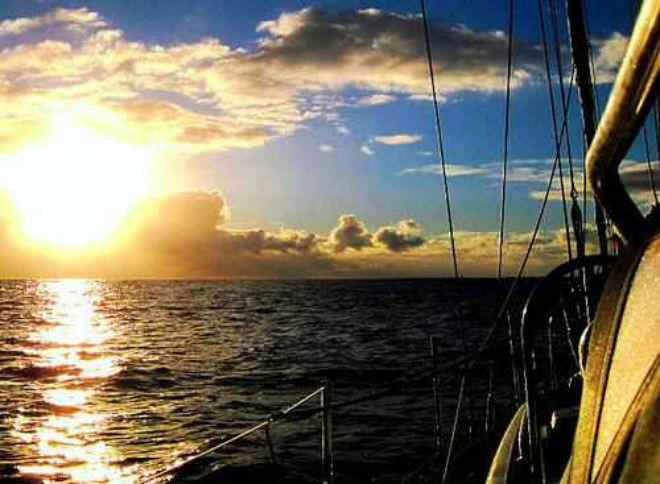How to make a distance scale for faster navigation
by Captain John Jamieson on 28 Sep 2014

Captain John Jamieson
If you are anything like me, sailing navigation can be a challenge when short- or single-handed sailing. But you still need to be able to plot fast and accurate positions for sailing safety. Here one little-known sailing tip used by the pros that will help you do just that!
Distance scale measurements on a chart can be a pain--in particular on an unstable platform like a sailboat in a seaway. Sure, you can use the Latitude scale, but that requires you to move back and forth across the chart from the Latitude scale on the left of right margins back to your plotting area. You can lose your place in the blink of an eye. Why not make a portable scale you can use right next to your plotted sailing course? It's fast and easy.
Just how important are distance measurements in navigation? Recall that distance forms one third of the foundation we call navigation: Time, Speed, and Distance. In order to calculate Time or Speed, you must measure Distance. Once you know your distance, you will be able to:
* Calculate time to turn onto the next course.
* Estimate time of arrival at a destination.
* Plot a DR position for safe navigation.
* Plan for landfall or for arrival at an anchorage .
* Find your actual sailing speed over ground.
* Sail between two points to determine speed.
* Provision with food, water and fuel for cruising.
Follow the five steps below to make a customized distance scale for the coastal or inland navigation charts aboard your small sailboat.
Materials you will need:
- Plain poster board or similar heavy stock.
- Fine tip laundry or permanent marker pen.
- Plotting compass or dividers and pencil.
- Scotch brand transparent tape or similar.
1. Find the Printed Distance Scale
Look near the title block (illustration above) or near the border of any large scale chart to locate the distance scale. Note on the 1:40,000 scale coastal chart, a marked distance scale has been printed near the title block. We are interested in just the scale that shows nautical miles and increments of nautical miles.
2. Create a Distance Scale Template
Cut a strip of stiff poster board one to two inches wide and nine or ten inches long. No set rules here. Tailor the length to your needs. Just be sure that the length covers about four nautical miles on a coastal chart and two nautical miles on a larger scale inland waters chart (larger than 1:80,000).
Mark in big, bold numbers the specific chart distance scale on your template. Note on the illustration below we have marked this template 1:40,000. You want to use this distance scale only on those charts with a scale of 1:40,000. That's critical. Do not mix up distance scales. Always double check the distance scale on the chart that you are about to use (located beneath the chart title).
3. Mark Off Nautical Miles and Tenths
Draw a long horizontal line. Find the distance scale on your large scale chart. Line up the poster board line with the charted distance scale. Mark it just like that shown in the illustration. Notice that the '0' will be marked one nautical mile above the termination point of the scale.
4. How to Use Your Distance Scale
Use your plotting compass or dividers. Beneath the '0', distances are marked at one-tenth nautical mile intervals. That way, you can measure odd distances quick and easy. For example, to spread out a distance of 2.3 miles, stick the needle point on your plotting compass (or one leg of our dividers) into the third mark beneath the '0'. Spread the other leg until it touches the two nautical mile mark on the scale.
Use the same procedure to find out the distance you've already measured on your nautical chart. Move the tool up or down until the upper leg touches an even nautical mile. Sweep the bottom leg over the increments beneath the '0'. Wherever the tool touches beneath the '0' will be the increment you add to the whole nautical miles.
5. Use 'Mid-Latitude' Measurements when Sailing Offshore
Plot distances with the latitude scale on charts used for offshore sailing. Take your distance measurements from the mid-latitude of the chart (central part of the latitude scale). This will be more accurate because this will help take into account the distortion caused by transference of the curved surface of the earth to the flat plane of a nautical chart.
Distortion will be minimal on larger scale coastal or inland charts; it will increase as the chart scale becomes smaller. It's a good habit to take distances from any chart near the mid latitude of the chart, but it's vital to do so on a super small scale chart (i.e. one that shows large expanses of ocean surface).
Captain John's Sailing Tip: Use a layer or two of transparent tape to protect your scale from moisture and 'puncture wounds'. When the tape gets old, peel it off and add another layer to help extend the life of your scale.
~~~~~~~~~~~~~~~~~~~~
Boost your sailing navigation safety with sailing tips that save you time and effort when shorthanded. Sail safer this sailing season--wherever you choose to sail or cruise on the waters of the world.
John Jamieson (Captain John) with 25+ years of experience shows you the no-nonsense cruising skills you need for safer sailing worldwide. Visit his website at Skipper Tips. Sign up for the Free, highly popular weekly 'Captain John's Sailing Tip-of-the-Week'. Discover how you can gain instant access to 1000+ sailing articles, sailing skills videos, sailing tips newsletters and Free sailing topic e-Books!
If you want to link to this article then please use this URL: www.sail-world.com/127208